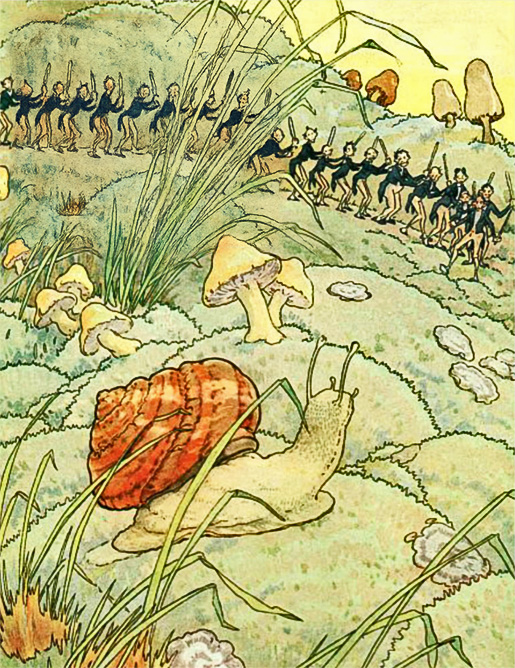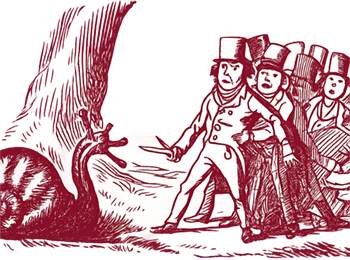Four-and-twenty Tailors
Four-and-twenty tailors
Went to kill a snail;
The best man among them
Durst not touch her tail;
She put out her horns
Like a little Kyloe cow.
Run, tailors, run, or
She'll kill you all just now.

“Four-and-Twenty Tailors” is one of those nursery rhymes built around a joke at someone’s expense. This time the unlucky targets are tailors — twenty-four of them, no less — who are terrified by a single snail.
Lyrics
Four-and-twenty tailors
Went to kill a snail;
The best man among them
Durst not touch her tail;
She put out her horns
Like a little Kyloe cow.
Run, tailors, run, or
She’ll kill you all just now.
Origins
The rhyme appears in collections from the 18th century onward, but the humor is older. In English folk tradition, tailors were easy targets. They were thought of as frail, fussy, and unmanly — men of cloth rather than of strength. There’s even a saying that it takes “nine tailors to make a man.” This little verse exaggerates the theme: even two dozen of them together can’t best a garden snail.
The line about the Kyloe cow points north to Scotland. The Kyloe (or Highland) cattle were small, shaggy cows with long horns. Comparing a snail’s feelers to those horns gave the animal an oddly menacing image.
Meaning
At heart, this is comic nonsense. The weak become ridiculous, the tiny becomes terrifying. Children would have laughed at the thought of grown men scattering from a snail.
It also carried a social jab. Just as cobblers, tinkers, and barbers had their stock jokes, tailors were mocked for being timid. The rhyme works as a short taunt: don’t be like the tailors, frightened by a snail’s horns.
Cultural Background
 Nineteenth-century illustrators loved this rhyme. Picture books often showed the tailors in aprons and shears, eyes wide in fear, while a snail loomed with outsized horns. The absurd mismatch made it a natural for comic art.
Nineteenth-century illustrators loved this rhyme. Picture books often showed the tailors in aprons and shears, eyes wide in fear, while a snail loomed with outsized horns. The absurd mismatch made it a natural for comic art.
The phrase “four-and-twenty” has an old ring to it. It turns up in other rhymes too — most famously Sing a Song of Sixpence (“four-and-twenty blackbirds baked in a pie”). It’s a poetic way of saying twenty-four, rooted in older English counting.
Legacy
These days the rhyme isn’t on the tip of everyone’s tongue, but it still finds a place in big Mother Goose collections. What keeps it alive isn’t a lesson or a moral — it’s the picture. Twenty-four tailors, scissors in hand, running in terror from a snail that sticks out its horns like a tiny cow.
It’s silly, it’s lopsided, and that’s the point. The rhyme captures a bit of old folk humor and bottles it up for children. Tailors might not be the butt of jokes anymore, but here they’re forever the men who couldn’t stand up to a snail.